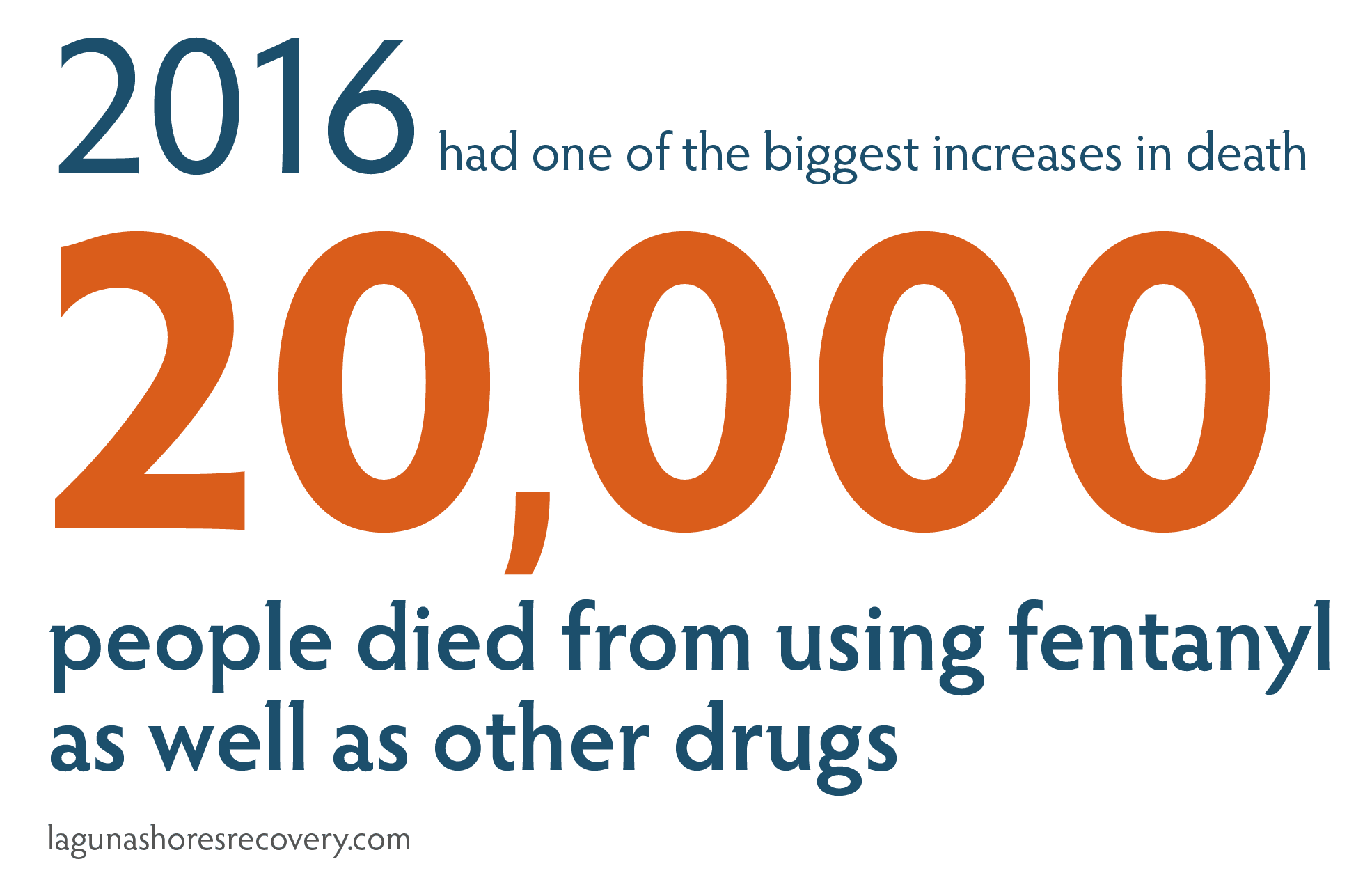Laguna Shores Recovery
What Is Fentanyl?
Chemists make fentanyl in a laboratory to have a similar chemical structure to that of the opium poppy plant.1 However, chemists have chemically modified it so that it is more potent than poppy plants or many other forms of pain-relieving medications, including morphine and Demerol. When it’s taken, the drug binds to opioid receptors present in the brain. This blocks pain sensations, but also has side effects that can include nausea, drowsiness, confusion, constipation, and extremely slow to no breathing. The effects on breathing make it easy to overdose on the drug.
Pharmaceutical companies manufacture and sell fentanyl under brand names that include Actiq, Duragesic, and Sublimaze.1 Manufacturers produce this drug in many forms. These include a pill, intravenous (IV) injection, patch, or even a lozenge that is similar to a cough drop.

How Can Fentanyl Be Detected?
Doctors can test a person’s bloodstream for the presence of opiates. They can also test for the presence of other drugs, such as methamphetamines and benzodiazepines.
What Are Fentanyl’s Effects?
In addition to strong cravings and losing control over how much fentanyl a person takes, other signs of addiction include experiencing withdrawal symptoms. Symptoms can occur when withdrawing from fentanyl, whether it has been used legally or illegally.
Some withdrawal symptoms include:1
- Muscle pain
- Problems sleeping
- Diarrhea
- Uncontrolled leg movements
What Are Some Signs and Symptoms of Fentanyl Addiction?
- Appearing very slowed and lethargic, sometimes suddenly. This may look like heavy limbs and not speaking clearly.
- Withdrawal symptoms first thing in the morning. This can include nausea, shaking, confusion, and muscle aches.
- Taking a medication other than as prescribed, such as taking larger amounts of it or crushing and snorting it instead of using it in a pill form.
- Engaging in risky behaviors to get more fentanyl, such as stealing money from friends and family, stealing prescriptions, or “doctor shopping” to try and get more fentanyl.
- Becoming more and more secretive with one’s actions and activities.
- Experiencing changes in appearance, such as losing weight or appearing more unkempt than usual.
Be Brave. Get Help.
What Are Misconceptions About Fentanyl?
A person can overdose on fentanyl because it affects areas in the brain that impact respiration and breathing. A person may take small, shallow breaths or not breathe at all when taking it. As a result, their brain can’t get enough oxygen. This leads to a condition known as hypoxia. A person with hypoxia can go into a coma or experience permanent brain damage. It is also possible to die from hypoxia if the condition is not recognized and quickly corrected.
The number of fentanyl-related deaths is steadily increasing. In 2010, the number of opioid-related deaths connected to fentanyl was 14.3 percent. In 2017, the number increased to 59 percent, according to the National Institute on Drug Abuse.1
Another common misconception is that all fentanyl sold on the streets is medical-grade and made safely in laboratories. This is far from the truth. Doctors often attribute fentanyl as one of the main drugs responsible for the “third wave” of the opioid epidemic.2 In 2013, medical and emergency responders began to see a sharp increase in the amount of people experiencing overdoses related to the drug. 2016 had one of the biggest increases, with an estimated 20,000 people dying from using fentanyl as well as other drugs.2 One of the reasons for this increase is that drug dealers in other countries began to illegally manufacture fentanyl in an attempt to incorporate it into other drugs, such as heroin. Therefore, some fentanyl sold on the streets is medical-grade while other’s are not.

According to “USA Today,” an estimated 80 percent of the United States’ illegal fentanyl that is seized comes from China.4 Currently, China hasn’t declared fentanyl a controlled substance, which means that drug traffickers can legally manufacture and manipulate the chemical recipe to the United States. However, because it is illegal in the United States, it is illegal to import the drug to the country.
What Do I Do If I See a Fentanyl Overdose?
If a person suspects someone may have overdosed, they should first call 911. Ideally, emergency rescue personnel can reach the person before their hypoxia is too prolonged and they experience permanent brain damage.1 Emergency rescue personnel can administer a medication called naloxone (Narcan) in cases of overdose on fentanyl and other opioids. This medication essentially knocks fentanyl off the opioid receptors, which reverses the effects of the drug.
Many states have passed laws allowing people to get naloxone from a pharmacist without a prescription. It can be a good idea to have naloxone or narcan if a loved one takes or is addicted to fentanyl or other opiates. Pharmacies can dispense Narcan as a nasal spray (sold as NARCAN nasal spray) or injectable medication, which is called EVZIO.
A lot of people may think that if they give their loved one Narcan, they won’t have to call paramedics or authorities for additional help.1 A person who has overdosed and received Narcan still needs medical help. This is because sometimes the fentanyl dose can last longer than Narcan does in the body. As a result, a person could stop breathing again in a few hours after they took the Narcan, even though they haven’t taken any more fentanyl. Also, it is a safer idea for a person to be examined by medical professionals to ensure they do not have any potentially long-lasting and reversible effects from an overdose.
No one likes to imagine that their friend or loved one could suffer from an overdose, but the truth is that overdoses happen in greater numbers everyday. Being prepared with a medication such as naloxone can be a life-saving one.
Be Brave. Get Help.


 Matthew Beck B.A, M.A, LMFT
Matthew Beck B.A, M.A, LMFT 


